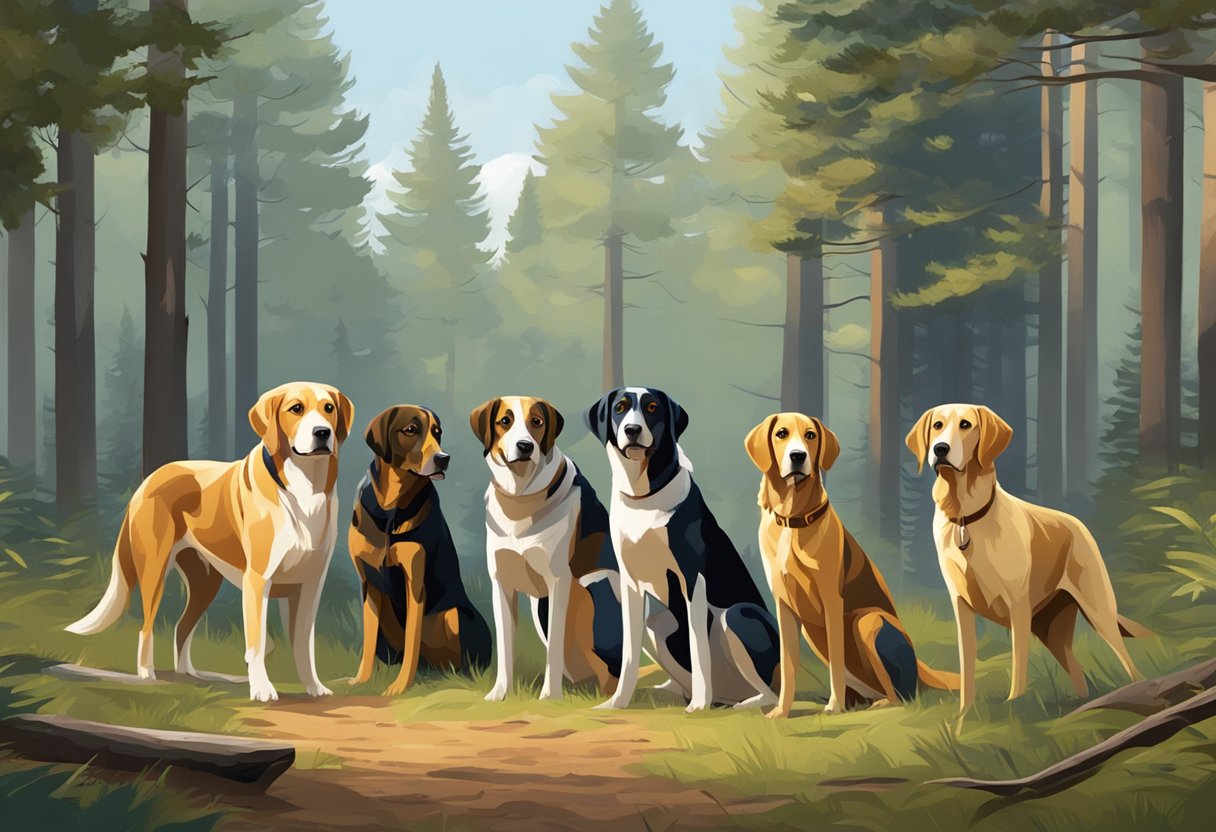Types Of Hunting Dogs
Hunting has been a part of human life for centuries, and hunting dogs have been a crucial part of the process. These dogs are specially bred and trained to assist hunters in locating, flushing out, and retrieving game. There are many different types of hunting dogs, each with its own unique set of characteristics and skills.
The history of hunting dogs can be traced back to ancient times, where they were used by hunters to track and capture game. Since then, the breeding and training of hunting dogs have evolved, resulting in a diverse range of breeds that are specialized for different types of hunting. From retrievers to hounds, each breed has its own strengths and characteristics that make them well-suited for certain types of hunting.
In this article, we will take a closer look at the different types of hunting dogs, their history and role in hunting, their classification, and the characteristics and skills that make them effective hunters. We will also discuss training and working with hunting dogs and highlight some of the most popular hunting dog breeds.
Key Takeaways
- Hunting dogs have been an essential part of hunting for centuries.
- There are many different types of hunting dogs, each with unique characteristics and skills.
- Understanding the history, classification, and training of hunting dogs can help hunters choose the best breed for their needs.
History and Role of Hunting Dogs

Hunting dogs have been an integral part of human hunting for thousands of years. They have been selectively bred over generations to hone their hunting instincts, making them efficient and reliable hunting companions. In this section, we will explore the evolution of hunting breeds and the role of dogs in human hunters’ lives.
Evolution of Hunting Breeds
The evolution of hunting breeds can be traced back to ancient civilizations, where early humans formed a mutually beneficial relationship with wild canines. Paintings and artifacts from the earliest recorded times provide evidence of humans and dogs hunting together for survival and sustenance. Over time, humans selectively bred dogs to enhance their hunting abilities, resulting in the development of various hunting breeds.
Hunting breeds can be broadly classified into three categories – hounds, gun dogs, and terriers. Hounds are known for their exceptional sense of smell and are used to track game. Gun dogs are trained to retrieve game birds and waterfowl. Terriers are small and agile dogs that are used to hunt small game like rodents and rabbits.
Dogs in Human Hunters’ Lives
Hunting with dogs has been an essential part of human life for centuries. Hunting dogs have been used to track and retrieve game, flush out prey, and even guard their human companions. The bond between a hunter and their dog is unique, and many hunters consider their dogs to be their most trusted companions.
Today, hunting dogs are still widely used by hunters all over the world. The breed of dog used for hunting varies depending on the type of game being hunted and the hunting environment. For example, retrievers like Labradors and Golden Retrievers are popular choices for hunting waterfowl, while pointers and setters are used to hunt upland game birds.
In conclusion, hunting dogs have played an essential role in human hunting for thousands of years. The evolution of hunting breeds has resulted in the development of various breeds, each with unique hunting abilities. The bond between a hunter and their dog is special, and hunting dogs continue to be an essential part of hunting today.
Classification of Hunting Dogs
Hunting dogs are classified into different categories based on their skills and capabilities. These categories include hounds and scent hounds, gun dogs and retrievers, pointers and setters, spaniels and water dogs, and terriers and curs. Each category has its unique characteristics that make them suitable for specific hunting tasks.
Hounds and Scenthounds
Hounds and scent hounds are bred to hunt by sight or scent. They are further divided into three sub-categories: sighthounds, scent hounds, and lurchers. Sighthounds, such as Greyhounds, rely on their keen eyesight to spot and chase game. Scent hounds, such as Beagles, use their exceptional sense of smell to track prey. Lurchers are a crossbreed between sighthounds and other breeds, and they are often used for hunting rabbits and hares.
Gun Dogs and Retrievers
Gun dogs and retrievers are bred to retrieve game after it has been shot. They are further divided into three sub-categories: retrievers, flushers, and pointers. Retrievers, such as Labrador Retrievers, are excellent swimmers and are used to retrieve waterfowl. Flushers, such as Springer Spaniels, are used to flush game out of hiding. Pointers, such as German Shorthaired Pointers, are used to point out game to the hunter.
Pointers and Setters
Pointers and setters are bred to locate game and hold it in place until the hunter arrives. Pointers, such as English Pointers, use their keen sense of smell to locate game and then point it out to the hunter. Setters, such as Irish Setters, are used to locate game and then set or crouch in front of it to indicate its location to the hunter.
Spaniels and Water Dogs
Spaniels and water dogs are bred to flush game out of hiding and retrieve game from water. Spaniels, such as Cocker Spaniels, are used to flush game out of hiding, while water dogs, such as Portuguese Water Dogs, are excellent swimmers and are used to retrieve waterfowl.
Terriers and Curs
Terriers and curs are bred to hunt small game, such as rabbits and rodents. Terriers, such as Jack Russell Terriers, are used to hunt small game underground, while curs, such as Catahoula Leopard Dogs, are used to hunt game in open fields.
In conclusion, hunting dogs are classified into different categories based on their skills and capabilities. Each category has its unique characteristics that make them suitable for specific hunting tasks. It is essential to choose the right hunting dog for the job to ensure a successful hunt.
Characteristics and Skills
Hunting dogs come in various breeds, each with its unique set of physical attributes, temperaments, and skills. In general, hunting dogs possess a combination of athleticism, keen senses, and a strong prey drive, making them excellent companions for hunters.
Physical Attributes and Athleticism
Physical attributes play a crucial role in a hunting dog’s performance. Most hunting dogs have a muscular build, excellent endurance, and a keen sense of smell and hearing. They are agile and can run for long distances without getting tired. Some breeds, such as the Greyhound, are bred for speed, while others, like the Bloodhound, have a powerful nose that can track scents for miles.
Temperaments and Prey Drive
Temperament is another critical factor that distinguishes hunting dogs from other breeds. Hunting dogs are bred to be independent thinkers, highly trainable, and have a strong prey drive. They are alert, focused, and have a natural instinct to hunt. However, their prey drive can make them aggressive towards other animals, so early socialization and training are crucial.
Tracking and Retrieving Abilities
Tracking and retrieving are two essential skills that hunting dogs must possess. Retrievers, such as the Labrador Retriever, are excellent at retrieving game from water and land. Pointers, such as the English Pointer, are bred to point at game birds, while hounds, such as the Beagle, are used for tracking game by scent.
In conclusion, hunting dogs possess a unique set of skills and characteristics that make them ideal companions for hunters. Their athleticism, keen senses, and strong prey drive make them excellent at tracking and retrieving game. However, their temperament can make them challenging to train, so early socialization and training are crucial.
Training and Working with Hunting Dogs
Hunting dogs are trained to work in the field, and they require specialized training to be effective. The following subsections cover basic training principles, advanced hunting techniques, and care and maintenance for hunting dogs.
Basic Training Principles
Training a hunting dog requires patience, consistency, and positive reinforcement. Basic training principles include obedience training, socialization, and exposure to different hunting environments. Obedience training teaches the dog to respond to basic commands such as sit, stay, and come. Socialization exposes the dog to different people, animals, and environments. Exposure to different hunting environments helps the dog become familiar with the sights, sounds, and smells of the field.
Advanced Hunting Techniques
Advanced hunting techniques include training the dog to track, retrieve, and point. Tracking involves teaching the dog to follow a scent trail left by game. Retrieving involves teaching the dog to retrieve game that has been shot. Pointing involves teaching the dog to locate game and freeze in place to indicate its presence. These techniques require specialized training and practice to be effective.
Care and Maintenance
Hunting dogs require regular care and maintenance to stay healthy and perform at their best. This includes feeding the dog a balanced diet, providing regular exercise, and grooming the dog’s coat. It also includes regular visits to the veterinarian for vaccinations, checkups, and treatment of any health issues. Proper care and maintenance help ensure that the dog is healthy, happy, and ready to work in the field.
In conclusion, training and working with hunting dogs requires specialized skills and knowledge. Basic training principles, advanced hunting techniques, and care and maintenance are all important aspects of working with these canine companions. With patience, consistency, and positive reinforcement, hunting dogs can be trained to be effective and reliable partners in the field.
Popular Hunting Dog Breeds
When it comes to hunting, having a good hunting dog can make all the difference. There are several breeds of dogs that are commonly used for hunting, each with their own unique set of skills and characteristics. Here are some of the most popular hunting dog breeds:
Retrievers and Labrador Retriever
Retrievers are a popular breed of hunting dog because of their ability to retrieve game from water and land. They are also known for their friendly and loyal temperament, making them great family pets. The Labrador Retriever is one of the most popular breeds of retrievers and is often used for duck hunting. They are known for their high energy, intelligence, and trainability.
Spaniels and English Springer Spaniel
Spaniels are another popular breed of hunting dog, known for their ability to flush out game birds from dense cover. The English Springer Spaniel is a popular breed of spaniel and is often used for upland bird hunting. They are known for their high energy, intelligence, and trainability.
Pointers and German Shorthaired Pointer
Pointers are a breed of hunting dog that are used to locate game birds and then point to their location. The German Shorthaired Pointer is a popular breed of pointer and is often used for upland bird hunting. They are known for their high energy, intelligence, and trainability.
Hounds and Beagle
Hounds are a breed of hunting dog that are known for their keen sense of smell and ability to track game. The Beagle is a popular breed of hound and is often used for small game hunting. They are known for their friendly and outgoing temperament, making them great family pets.
Overall, there are many different breeds of hunting dogs to choose from, each with their own unique set of skills and characteristics. When choosing a hunting dog, it is important to consider the type of game you will be hunting, as well as your own personal preferences and lifestyle.






